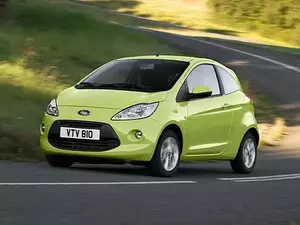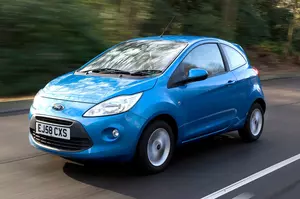
| Vehicle | Curb weight | Difference from world's smallest | Weight to power ratio | 0—60 mph acceleration ratio | Consumption ratio |
|---|---|---|---|---|---|
| 1.0i |
1045 kg / 2304 lbs |
620 kg (1367 lbs) heavier | 13 kg to 1 hp | - | - |
| 1.0e |
1045 kg / 2304 lbs |
620 kg (1367 lbs) heavier | 12 kg to 1 hp | - | - |
| 1.5i |
1072 kg / 2364 lbs |
647 kg (1427 lbs) heavier | 8 kg to 1 hp | - | - |
| 1.5e |
1072 kg / 2364 lbs |
647 kg (1427 lbs) heavier | 8 kg to 1 hp | - | - |
| Vehicle | 1.0i |
|---|---|
| Curb weight |
1045 kg / 2304 lbs |
| Difference from world's smallest | 620 kg (620 lbs) heavier |
| Weight to power ratio | 13 kg to 1 hp |
| 0—60 mph acceleration ratio | - |
| Consumption ratio | - |
| Vehicle | 1.0e |
| Curb weight |
1045 kg / 2304 lbs |
| Difference from world's smallest | 620 kg (620 lbs) heavier |
| Weight to power ratio | 12 kg to 1 hp |
| 0—60 mph acceleration ratio | - |
| Consumption ratio | - |
| Vehicle | 1.5i |
| Curb weight |
1072 kg / 2364 lbs |
| Difference from world's smallest | 647 kg (647 lbs) heavier |
| Weight to power ratio | 8 kg to 1 hp |
| 0—60 mph acceleration ratio | - |
| Consumption ratio | - |
| Vehicle | 1.5e |
| Curb weight |
1072 kg / 2364 lbs |
| Difference from world's smallest | 647 kg (647 lbs) heavier |
| Weight to power ratio | 8 kg to 1 hp |
| 0—60 mph acceleration ratio | - |
| Consumption ratio | - |

| Vehicle | Curb weight | Difference from world's smallest | Weight to power ratio | 0—60 mph acceleration ratio | Consumption ratio |
|---|---|---|---|---|---|
| 1.2 Ti-VCT |
934 kg / 2059 lbs |
509 kg (1122 lbs) heavier | 11 kg to 1 hp | 74 kg/s (163 lbs/s) |
187 kg/L (412 lbs/L) |
| Vehicle | 1.2 Ti-VCT |
|---|---|
| Curb weight |
934 kg / 2059 lbs |
| Difference from world's smallest | 509 kg (509 lbs) heavier |
| Weight to power ratio | 11 kg to 1 hp |
| 0—60 mph acceleration ratio | 74 kg/s (163 lbs/s) |
| Consumption ratio |
187 kg/L (412 lbs/L) |

| Vehicle | Curb weight | Difference from world's smallest | Weight to power ratio | 0—60 mph acceleration ratio | Consumption ratio |
|---|---|---|---|---|---|
| 1.5 16V |
1048 kg / 2311 lbs |
623 kg (1374 lbs) heavier | 10 kg to 1 hp | - | - |
| 1.0 TiVCT 12V |
1022 kg / 2254 lbs |
597 kg (1317 lbs) heavier | 13 kg to 1 hp | - | - |
| Vehicle | 1.5 16V |
|---|---|
| Curb weight |
1048 kg / 2311 lbs |
| Difference from world's smallest | 623 kg (623 lbs) heavier |
| Weight to power ratio | 10 kg to 1 hp |
| 0—60 mph acceleration ratio | - |
| Consumption ratio | - |
| Vehicle | 1.0 TiVCT 12V |
| Curb weight |
1022 kg / 2254 lbs |
| Difference from world's smallest | 597 kg (597 lbs) heavier |
| Weight to power ratio | 13 kg to 1 hp |
| 0—60 mph acceleration ratio | - |
| Consumption ratio | - |

| Vehicle | Curb weight | Difference from world's smallest | Weight to power ratio | 0—60 mph acceleration ratio | Consumption ratio |
|---|---|---|---|---|---|
| 1.2 |
940 kg / 2073 lbs |
515 kg (1136 lbs) heavier | 14 kg to 1 hp | 76 kg/s (168 lbs/s) |
184 kg/L (406 lbs/L) |
| 1.3 TDCi |
1055 kg / 2326 lbs |
630 kg (1389 lbs) heavier | 14 kg to 1 hp | 85 kg/s (187 lbs/s) |
251 kg/L (553 lbs/L) |
| Vehicle | 1.2 |
|---|---|
| Curb weight |
940 kg / 2073 lbs |
| Difference from world's smallest | 515 kg (515 lbs) heavier |
| Weight to power ratio | 14 kg to 1 hp |
| 0—60 mph acceleration ratio | 76 kg/s (168 lbs/s) |
| Consumption ratio |
184 kg/L (406 lbs/L) |
| Vehicle | 1.3 TDCi |
| Curb weight |
1055 kg / 2326 lbs |
| Difference from world's smallest | 630 kg (630 lbs) heavier |
| Weight to power ratio | 14 kg to 1 hp |
| 0—60 mph acceleration ratio | 85 kg/s (187 lbs/s) |
| Consumption ratio |
251 kg/L (553 lbs/L) |

| Vehicle | Curb weight | Difference from world's smallest | Weight to power ratio | 0—60 mph acceleration ratio | Consumption ratio |
|---|---|---|---|---|---|
| 1.3 i |
890 kg / 1962 lbs |
465 kg (1025 lbs) heavier | 13 kg to 1 hp | 66 kg/s (146 lbs/s) | - |
| Vehicle | 1.3 i |
|---|---|
| Curb weight |
890 kg / 1962 lbs |
| Difference from world's smallest | 465 kg (465 lbs) heavier |
| Weight to power ratio | 13 kg to 1 hp |
| 0—60 mph acceleration ratio | 66 kg/s (146 lbs/s) |
| Consumption ratio | - |